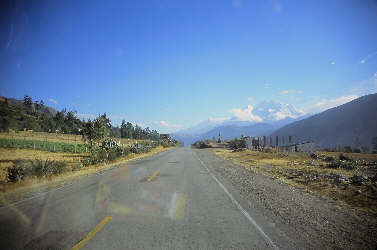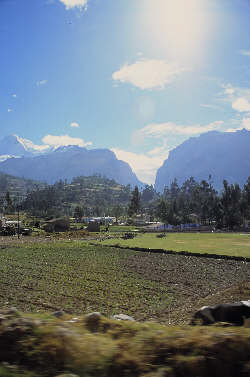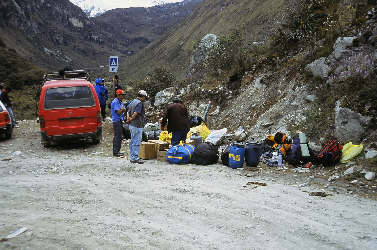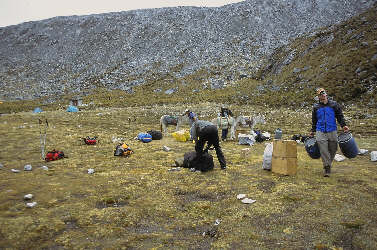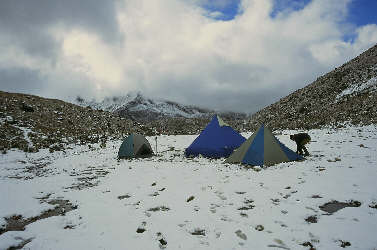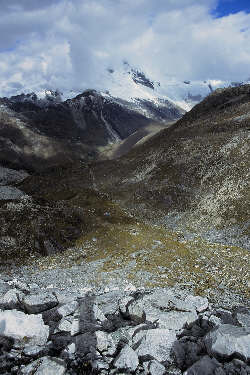|
||||||||||||||||||||
|---|---|---|---|---|---|---|---|---|---|---|---|---|---|---|---|---|---|---|---|---|
Nevado Pisco, Urus & Ischinca ExpeditionPisco Base CampDay 5 – Huaraz to Campo Baso de Pisco:July 5, 2004
Our ride was due to depart the from in front of the Familia Mesa at 7 a.m. so we were up by 5:30 to get ready and squeeze in a last hot shower. Jim and G pursued coffee jumpstarts while I headed for the sidewalk to await the arrival of the transport that Chris had lined up. The Toyota 4WD van arrived by 6:30 and the father/son team got a quick start in packing the immense amount of gear we would be hauling to the Pisco camp and then relocating to the Chopi mountain camps. While all of our climbing gear could fit on 1½ burros (not that half burros are commonly seen), the total estimated burro requirement was five. Elias arrived on time and we started moving the gear from the hallway, out the iron gate and onto the rack atop the van. With a bit of shoving here and shifting there, all was soon in place and tied securely for the three-hour move to the start of the trail to the Pisco base camp.
We pulled out promptly at 7 a.m. and for the sake of photos; I took a chance and opted for the front passenger’s seat. I knew from prior trips to Guatemala that the front seat in any transportation south of the border promised both the excitement of a Disneyland ride and ready access to a rosary in the event of catastrophic need. This ride was; however, a tame trip complete with seatbelts. We departed Huaraz through a warren of rough streets before dropping onto the main route out of town. From the edge of town on, the massive bulk of Huascaran loomed before us, giving no doubt as to the direction we were heading . . . up.
The road out of Huaraz heads north through Cuaraz and then onto Yungay before turning east and climbing into the Quebrada Llanganuco. Yungay bears the dubious distinction of being a new town but at a tremendous cost. The earthquake of 1970 leveled Huaraz but also caused the fall of a huge amount of ice from a glacier on the flank of Huascaran. The resulting avalanche of ice came down the valley, bringing with it a torrent of melt water, sediment, and debris. The alluvion reached Yungay and buried the town and its population of 18,000 under many feet of debris. Today, Yungay is again a town but in a different location and within sight of the old Yungay, now recognized by a large memorial to those still entombed below.
The turnoff from the main road at Yungay brings an end to the paved road as the route winds higher and higher in its quest for the mouth of the Llanganuco valley. One travels many miles up the winding road, passing farmer’s plots, men and women doing their day’s chores and kids joining in the labor as well. The scenes are typical of the developing world where some go to school, many do not, and eking out a living is the main goal of the day. Eventually, we reached the edge of Huascaran National Park and soon we pulled over at a gatehouse to register and pay our park entry fees. The cost for a 30-day gringo pass is US$20 and the formalities require little more than the cash and a passport number. A copy of the passport was fine but you are going to need that number to register and enter the park. We paid our fee and were back in the Toyota in no time.
Many photos of the Llanganuco show the two high lakes that lie just before the drop point for the hike to Pisco and the Huandoys. These lakes rest in an incredible glacier carved U shaped valley. Sure, if you’ve never had a course in geology you might not marvel at the U shape as compared to a V shape, but as a victim of more than a few geology classes I’m destined to make such patent observations. You travel along the first and then the second lake before gaining just a bit more elevation and stopping at a hairpin curve. This is the Pisco trail drop point and the where the transport goes from four-wheel drive to four-leg drive.
After three hours on the road, we were all ready to get out and bail into the unloading process. All of the stuff came down, gear bags, boxes of food and the myriad other items that would end up 3000 feet higher and a couple of miles distant by the close of the afternoon. We put everything in a heap on the side of the road as Elias disappeared down the hill to round up the arriero and his herd of burros. Soon enough, they appear, five burros and the driver and a few helpers, all ready to get our stuff lashed to the waiting pack train. The bags are sorted by weight and then one by one the burros are loaded. The arrieros know who is strong and who is not and they adjust the loads accordingly. The amount of weight that these animals carry is tough to imagine given the thoughts that occupied my mind, just lugging my gear through the airport a few days earlier. After perhaps 45 minutes all are ready to go and Elias too is ready to get a move on. A quick whistle and the four of us are heading down the short hill to cross a stream and pasture before heading up the trail to Campo Baso. The trail is not too steep but after a couple days travel, the move from 12k to nearly 15k does make for a fair effort. We were also not doing the hike barebacked as we were all carrying foul weather gear, a box lunch and whatever else we had little excuse for not getting onto the pack train. The hike leaves the valley and though Pisco is not apparent until perhaps the half way mark, the impressing figure of Chacaraju peers over the hills at the far end of the valley. Up we went with a steady rest step, figuring that one foot in front of the other would surely lead to the camp. . . eventually.
The trail eases a bit after the first 1500 feet of rise and there we took a ten minute breather and allowed the pack train to pass. We ended up following right along behind the burros for the next mile or so and another 1500 feet of ascent. The second 1500 feet generally takes the form of a series of switchbacks and traverses that get you atop a glacial bench, which previously hid the flank of Pisco. Now, however, the Pisco comes into view, along with the Huandoys, if the weather will permit you to see them. We got a glimpse here and there of Pisco but the higher Huandoys were to remain hidden for another day or two. We finally broke the crest and along with a group of five tired burros, we crossed a rocky flat to arrive at the Pisco base camp. Elias quickly picked the spot where he wanted the camp and bailed into getting the cook tent up and ready to go. We helped unload and sort the remainder of the gear, placing it wherever we could to keep it as dry as possible. Unlike the base camp we experienced in the Condoriri of Bolivia, this was not a rock camp, but instead a wet bog camp. You end up looking for dryer hummocks where you can get a tent up but with the realization that you will be surrounded by water filled potholes, and the floor of your tent will be on a mossy base. We got everything set up and then took a look in the cook tent. Elias was set up; hot water was ready and motioned for us to take both a seat and a cup of hot tea. Something told me that this cook gig was a good idea.
As mentioned earlier, the Peruvian winter is noted for the spells of good weather with the occasional off day but those bad weather days are few and snow is even more rare. Well, that was not to be the case in this camp and as we settled in to begin the laze around acclimatization process, we also hoped that the advancing clouds that had precluded any view of Chopi would lift and let us see not only our long term goal but perhaps even Pisco which we hoped to climb in just a matter of days. Such was not the case that afternoon and we ended up walking around a little bit and mostly hanging in the cook tent with Elias making tea, us fending off more tea, and then of course, trekking to the WC to get rid of tea. Actually, acclimatizing is a boring process, hence so many folks skip it or shorten it with the obvious disappointment that likely results. We knew the price to pay for climbing high and in reality the poor weather damped our spirits in a positive manner, letting us justify sitting out a few days “waiting for the skies to clear.” Dinner was next on the agenda and this was not just an affair where the cook heats up the stuff you would have eaten anyway. No, this is a multi course affair that starts with some crackers or popcorn in mid afternoon, followed by tea, followed by a first course of fresh soup prepared as you sit around and chat. Then comes the main course, usually a meat and two sides, seconds if desired, then desert and more tea or coffee. Desert is not just a Twinkie, but pudding, flan, or Jell-O. These dudes know their business. After dinner it was time to restart the Rummy 500 derby that was put on hold at the close of the Bolivia trip and soon enough we had Elias in the mix until it was dark and time to head for the individual tents. We headed in our different directions, me to my tent and G and Jim to the BD Megamid located on another nearby island.
Day 6 – Acclimatization and Moraine Climb:July 6, 2004 The day started early, as in right after midnight when the sound of heavy sleet beating against the dome of my tent woke me from a decent sleep. Things were going so well, I was really asleep and breathing well as compared to the quality of sleep I experienced at 15k at the start of the Bolivia trip. The sleet was coming down hard and I thought to myself, where in the hell is that blue sky/star strewn Peruvian winter sky? Actually, the surprise was minimal as a number of other climbers at Familia Mesa had just come in from the hills and said the mountain weather was unusual this year and to expect snow. I went back to sleep, not to wake for another couple of hours when the snow slid off one segment of the tent fly. I looked up and then took my hand and knocked the rest of snow from the dome, relieving it of a good four-inch accumulation. What a way to start a trip.
When we left the tents to join Elias in the big tent, the ground still had four inches of fresh snow but the temps clearly were not going to keep the accumulation around for very long. Though we did not get much real sun for another hour or two, the melt was soon on and by mid morning the snow was gone, replaced by the realization of why the ground was so damn wet when we arrived the previous afternoon. Elias made breakfast and once again, I could not have left the tent hungry if I had wanted to do so. We made our WC calls and generally figured to take the day easy and start adjusting to 15,000 feet. There is a Refugio above the Campo Baso and we made the hike up to check it out about mid morning. The hut was built and is maintained by an Italian charity that works with the poor of the Andean surrounding villages, who helped construct the structure in the first place. This refuge sleeps about 50 and has a really nice common area with meals for guests and walk-ins. There was nobody overnighting at the Refugio that day or any of the following days as the weather had been bad and the word was generally out that the conditions were not getting any better. We lazed about a bit, bought some Inca colas and took another down the path to Elias as he prepared lunch. We did lunch and then planned to hike to the top of the moraine that forms the first high ground leading from the camp to the flanks of Pisco and the Huandoys. The path up the moraine is plainly visible and promised to be a good first exertion above 15k. We took our time and hiked slowly up the diagonal path to the top of the ridge to scope out the drop onto the Huandoy glacier/moraine and the climb to the Pisco moraine camp. We had heard said that much of the challenge of Pisco is not the mountain but the moraine crossing that must be accomplished in the dark of the early morning departure or in the light of day should one break the climb with a moraine camp overnight. We had not decided if an overnight was in the cards, bouncing back and forth between doing a carry and camp at the moraine camp as compared to just doing the entire climb from the base camp. Regardless, we wanted to scope out this infamous moraine crossing before doing it the follow or morning after. 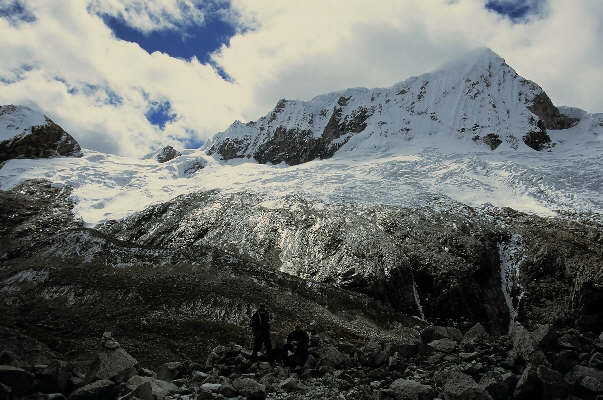
While standing and observing a party descending from the far ridge, we watched the far flank begin to shed boulders, turning the trail that they were about to take into an obvious death trap, ready to literally kill any who entered its bounds. Boulders shifted and fell, and I do not mean two footers. No, these were car and truck sized boulders, moving hundreds of feet down and across the trail, accompanied by multiple small and very fast moving projectiles, bouncing off the other rocks of the moraine. The barrage lasted a full ten minutes before settling enough that the Peruvian porter assisting the other group chanced making a run across the 100 yard stretch of rock trail, hoping for a safe crossing. The three American climbers waited, a bit more hesitant, but also making a literal run across that section of trail. The group made the crossing of the moraine’s base without incident and climbed to our location perhaps fifteen minutes later. They left no doubt about the impression this “moraine” had made upon them. We decided to strike out across the moraine ourselves, but just down the slope of our ridge and perhaps 1/3 of the way across the bottom in order to survey the route that disappeared into the boulder-strewn terrain. We were still unsure of our plans to make a haul the following day as compared to no haul and a heavy lift for the whole of the climb two days distant. As we regained the top of the ridge, we stopped and watched another boulder or two move, realizing as the 20,000 foot Huandoys came out from behind a curtain of cloud that we were not in Kansas anymore. This was not the land of the tame Colorado 14’er, this is the kind of place where you can get yourself killed. Elias had dinner on the stove when we got back and soon were putting down the calories in the name of acclimatization. Tea, coffee, soup, chicken, beans, salad, pudding, tea. You just gotta say no eventually. Then it was off to the tents and the hope for a clear period to come in the next two days. That’s all we wanted, one clear period to get a shot at Pisco.
|

